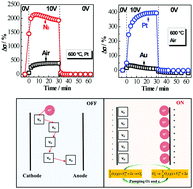Non-ohmic conduction in sodium bismuth titanate: the influence of oxide-ion conduction†
Abstract
A nominal Bi-excess starting composition of sodium bismuth titanate, Na0.5Bi0.51TiO3.015 (NB0.51T) produces dielectric ceramics that exhibit mixed n-type and oxide-ion conductivity with an ionic transport number of ∼0.1 at ≥600 °C. The bulk electrical conductivity, σb, of NB0.51T ceramics under a dc bias field of ≤100 V cm−1 has been investigated by impedance spectroscopy. Over the temperature range ∼550 to 750 °C, σb increases by up to one order of magnitude under the dc bias and returns to its initial value on removal of the bias. The enhancement of conductivity is dependent on temperature, atmosphere, dc bias field and the electrode materials. A maximum conductivity enhancement of >2000% is achieved at 600 °C in nitrogen using Pt electrodes. This is in contrast to that observed for other n-type perovskite titanates and oxygen-deficient rutile where σb is suppressed under a dc bias. This ‘unusual’ non-ohmic behaviour is attributed mainly to the influence of highly mobile oxygen vacancies in NB0.51T. The field-enhanced σb is best described to be a consequence of increased pumping of oxygen from the cathode to the anode, in which the electrode reactions play an important role. In addition, dissociation of defect clusters may also contribute to the enhanced σb under a dc bias. The high, fast and reversible response to the dc bias voltage may expand the potential application of NBT-based materials to memory devices.



 Please wait while we load your content...
Please wait while we load your content...